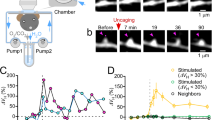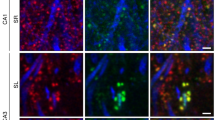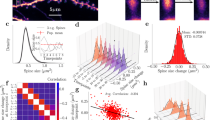Abstract
The stability of dendritic spines in the neocortex is profoundly influenced by sensory experience, which determines the magnitude and pattern of neural firing. By optically manipulating the temporal structure of neural activity in vivo using channelrhodopsin-2 and repeatedly imaging dendritic spines along these stimulated neurons over a period of weeks, we show that the specific pattern, rather than the total amount of activity, determines spine stability in awake mice.
This is a preview of subscription content, access via your institution
Access options
Subscribe to this journal
Receive 12 print issues and online access
$209.00 per year
only $17.42 per issue
Buy this article
- Purchase on Springer Link
- Instant access to full article PDF
Prices may be subject to local taxes which are calculated during checkout


Similar content being viewed by others
References
Holtmaat, A. & Svoboda, K. Nat. Rev. Neurosci. 10, 647–658 (2009).
Zuo, Y., Yang, G., Kwon, E. & Gan, W.B. Nature 436, 261–265 (2005).
Hofer, S.B., Mrsic-Flogel, T.D., Bonhoeffer, T. & Hubener, M. Nature 457, 313–317 (2009).
Trachtenberg, J.T. et al. Nature 420, 788–794 (2002).
O'Connor, D.H., Peron, S.P., Huber, D. & Svoboda, K. Neuron 67, 1048–1061 (2010).
Dantzker, J.L. & Callaway, E.M. Nat. Neurosci. 3, 701–707 (2000).
Sohal, V.S., Zhang, F., Yizhar, O. & Deisseroth, K. Nature 459, 698–702 (2009).
Kasai, H., Matsuzaki, M., Noguchi, J., Yasumatsu, N. & Nakahara, H. Trends Neurosci. 26, 360–368 (2003).
Fiser, J., Chiu, C. & Weliky, M. Nature 431, 573–578 (2004).
Linden, M.L., Heynen, A.J., Haslinger, R.H. & Bear, M.F. Nat. Neurosci. 12, 390–392 (2009).
Komiyama, T. et al. Nature 464, 1182–1186 (2010).
Thompson, W. Nature 302, 614–616 (1983).
Zhang, J., Ackman, J.B., Xu, H.P. & Crair, M.C. Nat. Neurosci. 15, 298–307 (2012).
Di Cristo, G. et al. Nat. Neurosci. 7, 1184–1186 (2004).
Roberts, T.F., Tschida, K.A., Klein, M.E. & Mooney, R. Nature 463, 948–952 (2010).
Arenkiel, B.R. et al. Neuron 54, 205–218 (2007).
Feng, G. et al. Neuron 28, 41–51 (2000).
Dombeck, D.A., Khabbaz, A.N., Collman, F., Adelman, T.L. & Tank, D.W. Neuron 56, 43–57 (2007).
Kuhlman, S.J., Tring, E. & Trachtenberg, J.T. Nat. Neurosci. 14, 1121–1123 (2011).
Holtmaat, A. et al. Nat. Protoc. 4, 1128–1144 (2009).
Pologruto, T.A., Sabatini, B.L. & Svoboda, K. Biomed. Eng. Online 2, 13 (2003).
Holtmaat, A.J. et al. Neuron 45, 279–291 (2005).
Acknowledgements
We wish to thank S.T. Carmichael for his help with quantitative real-time PCR, A. Silva for generously providing access to his two-photon microscope for some of these experiments, S. Kuhlman for her help with spike wave-form analysis, E. Ruthazer for critical comments on earlier versions of this manuscript and G. Feng (Massachusetts Institute of Technology) for generously supplying the Thy1-Chr2-YFP mice. This work was funded by grants from the US National Eye Institute (EY016052) and from the US National Institute for Mental Health (MH077972).
Author information
Authors and Affiliations
Contributions
R.M.W. conducted the longitudinal dendritic spine imaging experiments, analyzed the data and wrote the manuscript. E.T. conducted the awake, behaving cell-attached patch recordings. J.T.T. designed and supervised the project and wrote the manuscript.
Corresponding author
Ethics declarations
Competing interests
The authors declare no competing financial interests.
Supplementary information
Supplementary Text and Figures
Supplementary Figures 1–3 (PDF 3621 kb)
Supplementary Video 1
Video of head-restrained mouse maneuvering on a floating Styrofoam ball (MOV 3292 kb)
Supplementary Video 2
Video of a mouse wearing a head-fixed blue LED that is flashing at 2 Hz once every 2 seconds (MOV 3015 kb)
Supplementary Video 3
Video of a mouse wearing a head-fixed blue LED that is flashing at 10 Hz once every 10 seconds (MOV 3507 kb)
Rights and permissions
About this article
Cite this article
Wyatt, R., Tring, E. & Trachtenberg, J. Pattern and not magnitude of neural activity determines dendritic spine stability in awake mice. Nat Neurosci 15, 949–951 (2012). https://doi.org/10.1038/nn.3134
Received:
Accepted:
Published:
Issue Date:
DOI: https://doi.org/10.1038/nn.3134
This article is cited by
-
Driving Neurogenesis in Neural Stem Cells with High Sensitivity Optogenetics
NeuroMolecular Medicine (2020)
-
Is plasticity of synapses the mechanism of long-term memory storage?
npj Science of Learning (2019)
-
Optogenetic rewiring of thalamocortical circuits to restore function in the stroke injured brain
Nature Communications (2017)



